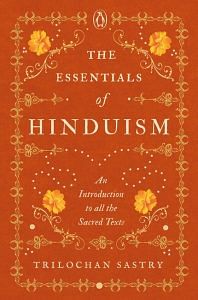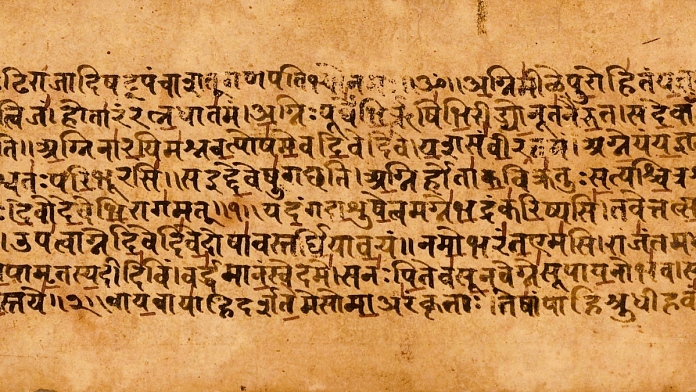The first portion of the Vedas is called the ‘Samhita’. This literally means ‘putting together’. More formally, it refers to hymns (or suktas) in specific poetic meters and arranged according to some rules. The hymns are said to be revelations of various sages or rishis. Each hymn consists of a set of mantras. The literal meaning of the word ‘mantra’ is ‘that which protects the mind’—manah (or mananat) trayate, iti mantra. By repetition and dwelling on its meaning, the mantra protects the mind. Mantras are also said to purify the mind. They are considered potent and said to have the power to confer temporal and spiritual benefits to those who chant them in the proper way.
To get a feel for the spirit of the Samhitas, some of the famous hymns are described. The spirit can only be captured by hearing the hymns chanted in the proper way in their entirety. One famous hymn is the Gayatri Mantra which was first revealed to the sage Viswamitra and is given in the Samhita of the Rig Veda. It also appears in the Yajur Veda and the Sama Veda. The opening phrase is as follows:
ॐ भूर्भुवस्वः| or Oṁ Bhūr Bhuva~Swah’ is an invocation.
The mantra has three lines of eight syllables each. This is now called the Gayatri metre and several other verses in the Rig Veda are composed in this metre.
Oṁ Bhūr Bhuva~Swah’, Tat savitur varenyam, Bhargo devasya dhīmahi, Dhiyo yo nah prachodayāt
—Rig Veda 3.62.10;
Yajur Veda, Chapter 36, Mantra (Verse) 3;
Sama Veda: 2.812
A word-by-word translation without interpretation is as follows:
tat–that (God); savitur–of the sun; varenyam–the best; bhargo (bhargas)–light, illumination; devasya–divine; dhimahi–let us meditate; dhiyo (dhiyah)–intelligence; yo (yah)–which; nah–our; prachodayat–may it push, inspire, illumine
The invocation ‘Om a sacred syllable indicating the Highest reality bhur-bhuva-swah’ denotes the earth, sky and space. It invokes in a sense the Highest Reality as the earth, sky and space.
There are many free translations which strive to convey the meaning in English. One such translation is:
That Sun (we) adore, on whose Supreme effulgence (we) meditate. May that Light illumine our intellect (or us).
This famous mantra, discovered by Viswamitra is considered to be very powerful and purifies those who practice or repeat it daily with sincerity. It can also lead to the highest goal of life—to illumination. The ‘Sun’ here does not refer to the physical sun. It is a symbol of light, denoting the Highest on which we meditate.
Another famous mantra often quoted from the Samhita is:
एकं सद्विप्रा बहुधा वदन्ति
Ekam Sat, Vipra Bahudavadanti
This can be translated as: ‘The Truth is One, the wise call it by various names.’ It indicates that though there are a multitude of gods and deities like Agni, Indra and so on, they all refer to One God or Reality. In Vedic times, the later religions did not exist. In the spirit of this Vedic shloka or verse, all concepts of God come from that One Truth This can be translated as: ‘The Truth is One, the wise call it by various names.’ It indicates that though there are a multitude of gods and deities like Agni, Indra and so on, they all refer to One God or Reality. In Vedic times, the later religions did not exist. In the spirit of this Vedic shloka or verse, all concepts of God come from that One Truth which sages of different religions called by different names. In modern times, Sri Ramakrishna, a 19th-century sage, said ‘The Hindus call it jal, the Christians call it water, and Muslims call it paani. It refers to the same substance.’ In this sense, this Vedic mantra says that there is only One Truth and sages call it by various names.
Also read: Yoga and Kama are not said in same breath in India today. But it should
Another oft-quoted mantra is:
आ नो भद्राः क्रतवो यन्तु विश्वत:
Aa no bhadrah kratvo yantu visvatah
[Let noble thoughts come to us from every side]
—Rig Veda, 1-89
Another famous set of mantras is the Purusha Suktam in hymn 10.90 of the Rig Veda. It is found in the Shukla Yajur Veda Samhita 30.1-16, the Krishna Yajur Veda Aranyaka 3.12.1-18, an abridged version in the Sama Veda and in the Atharva Veda Samhita 19.6. This hymn is recited regularly during various religious events even today. It is an invocation of the Purusha, the Supreme Self. It refers to the Supreme Purusha in the opening mantra as One with a thousand heads, a thousand eyes and a thousand feet, pervading the entire universe and extending even beyond it. Already, we can see the concept of an all-pervading Reality which is in the universe as Immanent and beyond it as Transcendent. Some other inspiring verses in the Purusha Suktam include:
वेदा॒हमे॒तं पुरु॑ षं म॒हान्तम् |
आ॒दि॒त्यव॑र्णं॒तम॑सः॒पर॑स्तात् |
तमे॒वं वि॒द्वान॒मृत॑ इ॒ ह भ॑वति |
Vedahametam Purusha mahantam, aditya varnam tamasa parastaat.
Tam eva vidvan, amrutam iha bhavati
[I have known that Supreme Purusha, brilliant like the Sun, beyond all darkness. Thou alone are wise; (for such a wise person) Immortality is here.]
We see here one of the essential ideas in Hinduism. Not only is there an Ultimate reality, but I too can experience it. Its nature as partly explained here—it is brilliant like the Sun and beyond all darkness. Sages have said that it is not the physical light that is referred to here. Later, we shall see that the idea of ‘light’ to indicate illumination is used again and again in various scriptures, including some nonHindu ones. The idea that there is some ultimate heaven or redemption for which we have to wait after death is also missing. It says that Immortality is here and now.
The Hymn of Creation, called the Nasadiya Suktam, is another profound set of mantras. It is found in the Rig Veda Samhita (10:129). It is about the process of Creation itself and starts off with the following verses, freely translated into English, and shows the spirit of enquiry about the Origin of the Universe. Whether this is mere speculation, imagination, inspiration or some kind of revelation is a matter of individual interpretation. The mantra begins with the following verses:
Existence was not then, nor non-existence;
The world was not, the sky beyond was neither.
What covered the mist? Of whom was that?
What was in the depths of darkness thick?
Death was not then, nor immortality;
The night was neither separate from day,
But motionless did That vibrate
Alone, with Its own glory one—
Beyond That, nothing did exist.
In popular writings, this is sometimes compared to the Big Bang Theory of modern physics where the universe as we know it is believed to have originated from an infinitesimally high-density ‘substance’ followed by a big bang that, over millions of years, evolved into the sun, earth, planets and galaxies that we now see.
 This excerpt from ‘The Essentials of Hinduism’ by Trilochan Sastry has been published with permission from Penguin India.
This excerpt from ‘The Essentials of Hinduism’ by Trilochan Sastry has been published with permission from Penguin India.



